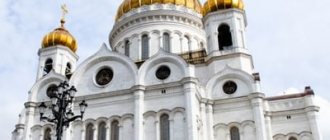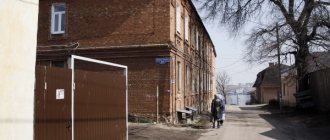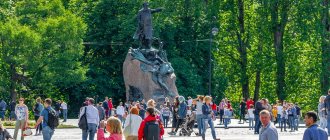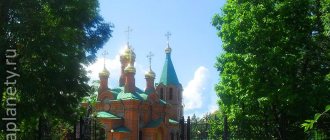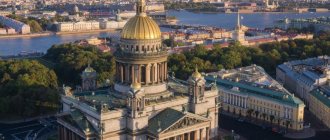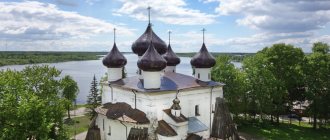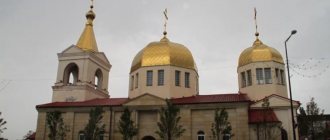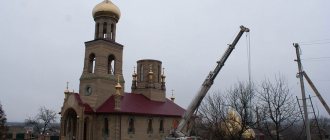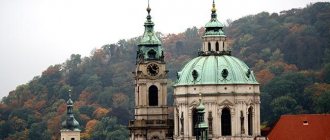In each city of Ancient Rus' there were several monasteries and dozens of churches. Then Russian Orthodox believed that for every 100-150 inhabitants it was necessary to have a separate church, so that everyone could offer their fervent prayer to God and hear an edifying sermon from the pulpit.
People in Ancient Rus' were very religious. They actively participated in the life of their parish, knew exactly the schedule of church services and always followed the rule of prayer at home. People lived amicably, and if one of the neighbors got married or had children baptized, the whole street celebrated these events. And in the same way, they gathered together for the funeral service of the deceased and saw off the deceased on the journey of the whole earth.
Tver was no exception either. There were several dozen churches in the city, which not only adorned the capital of the Upper Volga region, but also served as a solid spiritual foundation for the Orthodox people.
Construction of the main temple of Tver
Temples, first of all, were built in the Kremlin. The streets diverging in all directions from the Kremlin formed a posad, a place where the townspeople lived. The domes of churches could be seen everywhere between the roofs of the townsmen's huts. In ancient times, almost all townspeople's churches were wooden, but one ancient stone church has survived in Tver.
The construction of a stone church in those days was an expensive and troublesome task, therefore princes, boyars or rich merchants could build a stone church. In 1575, the Moscow merchant Gavril Andreevich Tushinsky began to build the White Trinity in Tver, but he did not have enough money, and therefore another merchant, Peter Lamin, gave the missing part of the funds. The walls of the temple were made of red brick, but people still called the church, red as an Easter egg, the White Trinity.
Architecture
The Resurrection Cathedral was created in neo-Russian style; the building has a cubic shape with three apses, a large drum and a helmet-shaped dome. On the western side the building is adjacent to the vestibule and choir. The brick walls of the church were covered with cement mortar. The interior of the pillarless building was not painted with iconography. The decor is made in the style of Novgorod architecture.
In 2006, next to the Church of the Resurrection, a church was erected in the same architectural direction, which was consecrated in honor of the Romanov Passion-Bearers.
Why white?
Trinity-Sergius Lavra is the heart of Russian Orthodoxy. Gavril Andreevich Tushinsky came here to present the Lavra of St. Sergius with the newly built White Trinity Church in Tver.
In Rus' at that time there were 2 concepts: black and white lands. The sovereign exempted the owners of white lands from part of taxes for special merits. The Trinity-Sergius Lavra and everything that belonged to this monastery were precisely exempted from part of the taxes by state decree. Now the former tax benefit lives on in the historical name - White Trinity in Tver, and later the church walls themselves were plastered and whitewashed.
Where is the cathedral
The address of the Resurrection Cathedral in Tver is as follows: Barrikadnaya Street, before the revolution it was called Christmas Hills 1-1a. You can get to it by tram No. 13, 14 or minibus No. 2 to the “Nativity of Christ Monastery” stop. Even if you have some difficulties about how to get to the cathedral, do not worry. You can ask a passerby and he will definitely show you the right path.
In addition to admiring the beauty of this monastery, you can also go to the middle, light a candle, pray and ask the Lord for the most cherished thing for yourself and your loved ones. Remember that in addition to requests, you can simply thank you for what you have. Such prayers of gratitude will help not only to place higher powers towards you and your requests, but also to positively set you up for communication with the Lord.
God bless you!
Exterior and interior of the temple today
From the time of construction, only the forged gates and two small windows under the roof have been preserved in the temple. Through them, almost no light entered the interior of the church, but during the service it was quite light and cozy from the light of many burning candles. An abundance of light was created by ancient chandeliers. They have survived to this day, however, now the light is emitted not by candles, but by electric lamps. Some icons painted specifically for this temple have also survived to this day. True, now they are mostly in museums, and today's temple icons are not as ancient as the White Trinity itself in Tver, but their age is still 200-300 years.
The temple vaults were originally painted with white lime, and only 150 years ago they were touched by the brush of an isographer. The painting of the temple vaults was updated many times, and today you can see modern temple wall paintings. In the most ancient part of the temple there is a magnificent carved iconostasis. Behind him, in the altar, the Divine Liturgy has been celebrated for four and a half centuries.
Shrines[edit]
Icon of the Holy Trinity with a piece of Mamvrian oak
- Icon of the Prophet Elijah
- Icon of the Mother of God “Kazan”
- Icon of the Great Martyr. Panteleimon the Healer
- Pochaev Icon of the Virgin Mary
- Icon of St. Seraphim of Sarov
- Icon of St. Sergius of Radonezh
- Icon of the Holy Royal Passion-Bearers
- Icon of the Mother of God "Tikhvin"
- Icon of the Holy Apostles Peter and Paul
- Icon bgg. knn. Peter and Fevronia of Murom (in monasticism of David and Euphrosyne)
- Icon of the Holy Trinity with a piece of Mamvrian oak
- Icon of St. Luke (Voino-Yasenetsky)
- Icon of St. Nile, Stolobensky Wonderworker
- Icon of Methodius and Cyril, Slovenian teachers
- Icon of St. Nicholas of Myra
- Icon of the Holy Great Martyr George the Victorious
- Icon of the Mother of God “Inexhaustible Chalice”
- Icon of the Holy Princes Boris and Gleb
- Icon of the Venerable Mary of Egypt
- Icon of the Mother of God “Seeking the Lost”
- Icon of Saint Nina Equal to the Apostles
- Icon of the Holy Martyr Tatiana of Rome
- Temple Icon of the Mother of God “Unexpected Joy”
- Icon of St. Neil of Stolobensky with a particle of relics, as well as St. unmercenary Cosmas and Damian of Assia
- Temple icon of the holy martyrs and confessors Guria, Samon and Aviv
- Icon of St. Sergius of Radonezh, his parents, St. Cyril and Mary, with particles of the relics of saints
- Icon of the Apostle Andrew the First-Called with a particle of the relics of the saint
- Icon of the saint Matrona of Moscow with a particle of the saint's relics
- Icon of the Reverend Confessor Archimandrite Sergius (Srebryansky) with a particle of relics
- Icon of St. St. Basil's with a particle of relics
- Icon of the 14,000 infant martyrs killed by Herod in Bethlehem, with a particle of relics
Divine services at White Trinity
Today the schedule of White Trinity services in Tver is from 8:00 until late evening, depending on the event and day of the week.
The church also hosts bishops' services dedicated to important events in church Orthodox life. On weekdays it is performed by appointed clergy, priests and deacons, and on holidays and Sundays by the Tver Metropolitan himself. Readers and singers, who in the Russian Orthodox tradition are usually called clergy, participate in the service, being outside the altar, on the choir, reading and performing liturgical chants and texts. As in Ancient Rus', all these people live on the voluntary donations of parishioners.
History[edit]
The temple is located on the left bank of the Volga. The only one of the Tver churches that combines three architectural styles at once: Baroque, Classicism and Empire. Among the people, the Church of the Resurrection is better known by the name of one of the chapels - the Three Confessors: Guria, Samon and Aviva.
The church was consecrated in 1731.
There are three thrones: the main one of the Resurrection of Christ, the side altars: 1) the holy martyrs Guria, Samon and Aviv and 2) the Mother of God “Seeking the Lost.”
At this place, presumably since the 15th century, there was a wooden temple in honor of Paraskeva Pyatnitsa. In 1709, two wooden churches were mentioned - in honor of the Resurrection of Christ and the holy martyrs Guria, Samon and Aviv. By 1725, the Church of the Resurrection was completely dilapidated, and parishioners turned to Tver Bishop Theophylact for his blessing to build a new stone church.
Construction was carried out from 1728 to 1731 at the expense of the local merchant Gerasim Sedov. He traded hemp and bread in Vyshny Volochyok and other cities, and also held the positions of zemstvo burgomaster and headman “at worldly taxes,” and at the end of his life he decided to donate money for the construction of a new church in his parish.
In 1797-1805, the temple was renovated by the zeal of the eminent city dweller Makarii Blokhin. A new iconostasis was installed, the original external decoration was cut down and replaced with the existing one. The temple was consecrated again in 1806.
In 1815-1822, at the expense of the mayor of Yegor Zubchaninov, the southern chapel was erected according to the design of Karl Rossi, consecrated in honor of the Icon of the Mother of God “Seeking the Lost.”
This icon miraculously appeared in the Zubchaninovs’ house, located next to the temple, and more than once saved the family from various misfortunes. One year, Yegor Zubchaninov almost became a beggar from a rich merchant when the caravan he equipped died (only one ship survived), and Yegor Iudich was unable to fulfill his obligations to supply grain for the army. In a dream, he saw the Mother of God, who pointed him to the image of “Seeking the Lost,” which was kept in the house. The merchant Zubchaninov prayed fervently and made a vow that he would give all the money from the surviving ship as a gift to the Queen of Heaven. His affairs quickly improved, and in fulfillment of his vow, he built a chapel in honor of the Icon of the Mother of God “Seeking the Lost,” where he transferred his miraculous icon. The icons for the iconostasis were ordered by him from the Academy of Arts in St. Petersburg. Donations for the decoration of the temple were made by the merchant Andrei Vasilyevich Nazarov. The merchant Blokhin donated a chasuble for the icon made of large pearls with multi-colored stones and a silver-gilded frame and aureole. The chapel was consecrated by Archimandrite Gideon.
Religious processions were held with the Icon of the “Recovery of the Lost,” the inhabitants of the Volga region received it in their homes, and before the start of any business they served a prayer service in front of this image. Unfortunately, the fate of the miraculous image after the revolution of 1917 is unknown.
In the Church of the Resurrection there is currently a newly painted, venerated Icon of the Mother of God “Seeking the Lost.”
After the revolution of 1917, the church was closed, two tiers of the bell tower and frescoes were destroyed. Subsequently, the church was declared a monument of republican significance. During the years of Soviet power, the church building housed a health care museum, a health education center, and maritime and chess and checkers clubs. The Church of the Resurrection of Christ was transferred to the Tver diocese in 1993, and services began there in 1997.
To celebrate the 870th anniversary of the city of Tver in 2005, the bell tower was restored.
Secrets and legends of the Time of Troubles
Time has been kind to the White Trinity Church in Tver. Fires and other disasters passed him by. Even at the beginning of the 17th century, detachments of Poles did not cause any harm to the White Trinity. At that time of troubles, many Tver residents kept their simple belongings in the temple, even hiding themselves in hiding places under small domes. These hiding places have survived to this day, but then, at the beginning of the 17th century, the Poles still found those hiding and killed them right in the temple. After many decades, from time to time traces of blood appeared on the walls of the temple.
Metropolitan of Tver and Kashinsky Victor - mentor of the temple in Tver
The rector of the cathedral is His Eminence Metropolitan of Tver and Kashinsky Victor. The Metropolitan has a very long history with the White Trinity Cathedral in Tver: first he was a keymaster (1987), then he accepted the rank of archbishop (1996). Today, His Eminence Metropolitan Victor is the head of the Tver Metropolis and an honorary citizen of the city of Tver.
Ascension Cathedral Tver inside
The style of the cathedral can be attributed to neoclassicism. The square building is somewhat massive. There is a central drum under the semicircular dome. There is also a three-tier bell tower of a similar square shape.
The columns, cornices, plinth, steps and bell towers are made of white stone. The cathedral itself is painted ocher with white decorative details. Inside the cathedral there is a beautiful painting, the dome is decorated with an image of the sky.
The beauty of the interior is best seen from above, going up the stairs to the second floor, where the bookstore and church shop are located.
© Anna Strukova
Holy relics of St. Macarius of Kalyazin
The main asset of the White Trinity today can be called the presence within the walls of the temple of a shrine with the holy relics of St. Macarius of Kalyazinsky.
After the destruction of the Trinity Monastery in Kalyazin in the 30s of the 20th century, it was decided to preserve the relics in the main cathedral of the Upper Volga White Trinity in Tver. The schedule of services and veneration of the holy relics of the reverend wonderworker can be found in the monastery itself, but often you can venerate the relics on any day of the week.
Shrines
After the building was transferred to the Russian Orthodox Church, the iconostasis of the House of God was replenished with the “Sovereign” image of the Most Pure Virgin. During the Soviet period, the canvas was used as one of the doors in a utility building. A certain pious man bought the shrine from its owners, and then mercifully transferred it to the newly opened cathedral church.
The icon called “The Savior in a White Robe” is directly related to the name of the Venerable Saint Seraphim, who consecrated the temple immediately after its construction was completed. This hieromartyr was a former guardsman and took monastic orders with the blessing of I. Kronstadt. In 1937, the elderly Seraphim was shot by the Bolshevik authorities. The original of the shrine is kept in one of the Moscow churches. The list of the image was presented to the Resurrection Cathedral by the granddaughter of the saint named Seraphim.
